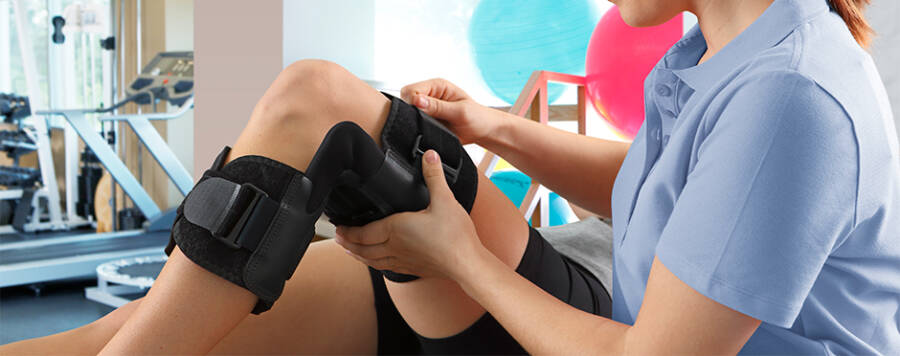What are braces?
Braces can be used during treatment as well as to prevent injuries. The goal of a brace is to provide external support to increase the stability of the joint. Braces can vary in support based on the material used, and can be purchased over the counter or custom fitted.
Conditions Braces are Commonly Used for:
- Fractures of leg or foot
- Wrist sprains
- Chronic ankle sprains
- Sprains of the knee ligaments (ACL, MCL, LCL, PCL), both pre- and post-operatively
Pros of Bracing in Sport
- Easily accessible, with a variety of brace options typically available at local stores
- Relieve pain by reducing stress on injured structures
- Limit movement of a joint to allow for healing
- Relatively easy to put on/ take off
- Can provide extra stability for return to sport, which has higher demands physically on the body
Cons of Bracing in Sport
- Braces do not replace a rehabilitation program
- Aesthetically unappealing
- Braces do not replace muscle strength
- Wearing a brace too long can cause over reliance on the external support
- Likewise can result in incorrect muscle activation patterns, potential muscle atrophy and decreased proprioception (joint awareness)
- A brace can decrease the load on the injured area but increase the load elsewhere due to compensations
Current Research:
In regards to preventing ankle injury, research has shown proprioception and balance exercises to be effective to reduce ankle sprains in those with previous ankle sprains. However the evidence for use of braces as a primary prevention for ankle sprains is inconclusive.2 There is moderate evidence to support the use of preventive ankle braces in adolescent athletes1 to reduce the incidence of acute ankle injuries. When we combine these findings, we can see that ankle braces can provide structural stability, which may prevent future sprains, but they do not provide the proprioception that our anatomical ligaments and muscles supply.
For knee injuries, there is mixed use of bracing post-operatively for knee ACL reconstructive surgery as some surgeons use a knee brace during the rehabilitation phase and others choose not to. Likewise, support is limited for use of a brace when returning to sport after ACL reconstruction to prevent re-injury.3 However, wearing a brace to return to play may improve an athlete’s confidence in their knee.
Conclusion:
Braces do not replace a quality strength and conditioning program. Oftentimes rehab exercises are only started after an injury and when the athlete returns to sport they may stop performing their rehab exercises. These strengthening and balance exercises are crucial as they can improve the stability of the joint itself as well as surrounding structures. Athletes and coaches should be performing a conditioning program as a part of their practice to help prevent injuries. It is strongly recommended that athletes have a good rehabilitation and return-to-sport program after they suffer an injury – even if they choose to wear a brace when they return to their sport.
If you are in need of a good rehabilitation strengthening program, schedule an appointment with our experts at a nearby Athletico location.
The Athletico blog is an educational resource written by Athletico employees. Athletico bloggers are licensed professionals who abide by the code of ethics outlined by their respective professional associations. The content published in blog posts represents the opinion of the individual author based on their expertise and experience. The content provided in this blog is for informational purposes only, does not constitute medical advice and should not be relied on for making personal health decisions.
References:
1. Farwell KE, Powden CJ, Powell MR, McCarty CW, Hoch MC. The effectiveness of prophylactic ankle braces in reducing the incidence of acute ankle injuries in adolescent athletes: a critically appraised topic. Journal of Sport Rehabilitation 2013; 22(2): 137-142.
2. Schiftan GS, Ross LA, Hahne AJ. The effectiveness of proprioceptive training in preventing ankle sprains in sporting populations: a systematic review and meta-analysis. J Sci Med Sport. 2015;18(3):238-44.
3. Lang PJ, Sugimoto D, Micheli LJ. Prevention, treatment, and rehabilitation of anterior cruciate ligament injuries in children. Open Access J Sports Med. 2017;8:133-141. Published 2017 Jun 12. doi:10.2147/OAJSM.S133940
About the Author:
Tara Hackney, a physical therapist in Marion, IA, enjoys working with all patient types, especially gymnasts, cheerleaders, and dancers. She is the prominent blogger for Athletico's Gymnastic/Cheer Program. With an orthopedic specialization and training in dry needling and Graston technique, Tara hopes to answer your questions about injuries and injury prevention in an easy-to-understand manner. She hopes to ease fears surrounding pain and injuries, address concerns about recovery, and provide tips to prevent injury. In her free time, she enjoys spending time with her dog, reading, and watching her nephews play sports.

 width="900"
height="356"
>
width="900"
height="356"
>
